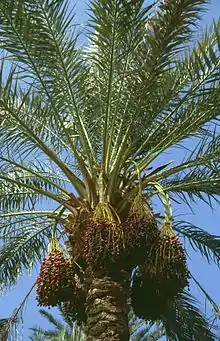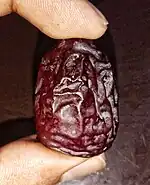Mazafati
Mazafati (Persian: مضافتی;[1] or mozafati and Bam date; also called muzati in Balochi) is a cultivar of the palm date. It is a dark, soft, fleshy and sweet date of medium size, about 2.5–4.5 cm (1–2 in) with a relatively high moisture content of between 32 and 35%, varying with the time of harvest and the location of the grove.
| 'Mazafati' date | |
|---|---|
 Mazafati date palm in Bam | |
| Genus | Phoenix |
| Species | Phoenix dactylifera |
| Cultivar | 'Mazafati' |
| Origin | |
Areas of cultivation
It is grown in the region of southern Iran, mainly in Bam, Jiroft, Kahnuj (in Kerman province), Saravan, Nikshahr, Haji Abad, and Iranshahr (in Sistan-o-Baluchestan province), Panjgur, Parom and Buleda in Pakistani province of Balochistan.
As one of the largest growing regions of Mazafati dates, the Bam region has around 28,000 ha (69,000 acres) under cultivation, of which about 5,000 ha (12,000 acres) are for young palm trees. It is estimated that Mazafati dates account for 20% of Iran's total export of dates. Approximately 120,000 tons are harvested from the land annually. Mazafati date palms can stay in production for over 60 years.
Consumption

The date is suited for fresh consumption, i.e., not dried.[2] At a temperature of −5 °C (23 °F) it can be kept for up to two years or at 0–5 °C (32–41 °F) it can be kept for one year. Mazafati date harvesting time depends on the variety and starts in August, lasting to the end of October.

This variety is the most common variety of fresh dates for snacking and table eating. It is a valuable source of nutritional elements for daily consumption as a fruit. It is rich in fiber content and vital elements.
Mazafati is a popular fruit for consumption in many countries. However, exports have been badly affected by international sanctions.
Content and nutrition
 | |
| Nutritional value per 100 g | |
|---|---|
| Energy | 1,105 kJ (264 kcal) |
51 g | |
| Sugars | 46 g |
| Dietary fiber | 26 g |
5.6 g | |
1.61 g | |
| Minerals | Quantity %DV† |
| Calcium | 22% 28-60 mg |
| Iron | 20% 2.6 mg |
| Phosphorus | 7% 50 mg |
| Sodium | 1% 16 mg |
| |
| †Percentages are roughly approximated using US recommendations for adults. | |
Mazafati date seeds are made up of 7.7–9.7% oil and make up 5.6–14.2% of the date's weight. They contain 7.17–9% moisture, 1.83–5.3% protein, 6.8–9.32% fat, 65.5% carbohydrates, 6.4–13.6% fiber, and 0.89–1.57% ash, as well as sterols, estrone, and an alkali-soluble polysaccharide. The fatty acids contained in the oil are 8% lauric, 4% myristic, 25% palmitic, 10% stearic, 45% oleic, and 10% linoleic acid, as well as some caprylic and capric acid.
The dates have nutrients including calcium, magnesium, potassium, vitamin A, vitamin B complex and vitamin C. Moreover, they are low in fat and high in fiber and protein content.
References
- Persian pronunciation: [mozɒːfæˈti];
- Goldenberg, Nathan (1989). Thought for Food: A Study of the Development of the Food Division, Marks & Spencer : an Autobiography. Orpington: Food Trade Press. p. 73. ISBN 9780900379352.
